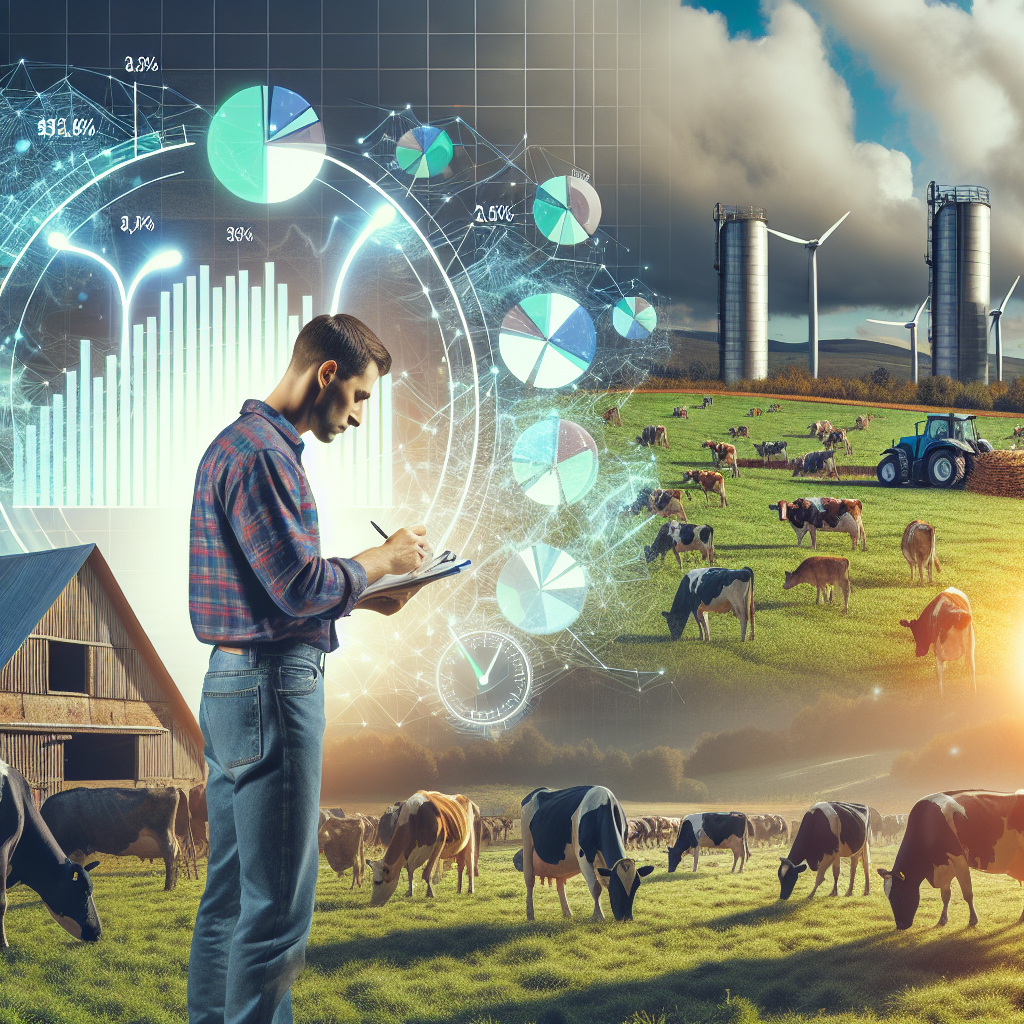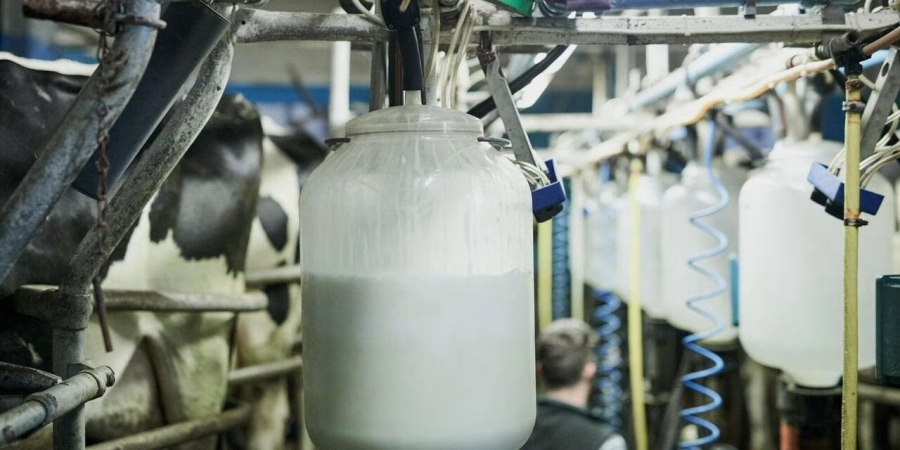Why are dairy farmers feeling hopeful despite financial challenges? What trends are fueling this optimism? Read on to find out.
Summary: Farmers are showing increased optimism despite financial concerns, as revealed by the latest Purdue University/CME Group Ag Economy Barometer, rising 8 points to 113 with improvements in current conditions and future expectations. High input costs and the risk of declining crop and livestock prices remain top concerns, although fears about rising interest rates have lessened. The Farm Financial Performance Index decreased slightly to 81, signaling ongoing worries about commodity prices. Meanwhile, the Farm Capital Investment Index showed a slight uptick to 38, indicating cautious optimism about future investments. Farmland value expectations presented a mixed picture, with short-term stability anticipated but long-term growth outlooks dimmer.
- Farmer sentiment improved in July, with the Ag Economy Barometer rising 8 points to 113.
- High input costs are the top concern for 34% of farmers, while 29% worry about lower crop and livestock prices.
- Concerns about rising interest rates have decreased, with only 17% of farmers citing it as a primary concern.
- The Farm Financial Performance Index dropped to 81, reflecting worries about commodity prices.
- The Farm Capital Investment Index increased slightly to 38, indicating cautious optimism about future investments.
- Farmland value expectations are mixed, with short-term stability but a lower long-term growth outlook.

Farmers’ attitudes have recently improved despite ongoing financial problems. It is not all doom and gloom in the agricultural industry. Dairy producers have unexpected reasons to be cheerful, such as enhanced farmer sentiment and a rise in the Farm Capital Investment Index. Despite lower maize and soybean prices, farmer mood rose in July. Join us as we look at the most recent statistics from the Purdue University/CME Group Ag Economy Barometer to see what variables increase morale among dairy producers. We’ll look at the facts, talk to experts, and find out what’s fueling this surprise optimism.
| Index | July 2024 | June 2024 | Change |
|---|---|---|---|
| Ag Economy Barometer | 113 | 105 | +8 |
| Index of Current Conditions | 100 | 90 | +10 |
| Index of Future Expectations | 119 | 112 | +7 |
| Farm Financial Performance Index | 81 | 85 | -4 |
| Farm Capital Investment Index | 38 | 32 | +6 |
| Short-Term Farmland Value Expectations Index | 118 | 115 | +3 |
| Long-Term Farmland Value Expectations Index | 146 | 152 | -6 |
Farmers’ Unexpected Optimism: What’s Driving the Recovery?
Unquestionably, farmer attitudes are improving. According to the most recent Purdue University/CME Group Ag Economy Barometer report, farmer confidence is up 8 points to 113. This isn’t just a blip on the radar; the Index of present Conditions rose by ten points to 100, indicating that farmers are more optimistic about their present condition than in prior months. Furthermore, the future seems better, as the Index of Future Expectations rose 7 points to 119. This increase shows that more farmers are cautiously enthusiastic about what’s ahead. Surprisingly, these shifts occur even as maize and soybean prices fall, indicating a complicated but robust agricultural picture characterized by fewer respondents reporting worsened conditions compared to a year ago and a decrease in those expecting adverse future outcomes.
Why Falling Corn and Soybean Prices Haven’t Crushed Farmer Sentiment
Corn and soybean prices fell 11% and 5%, respectively, which may have been worrying. However, it is strange that this did not diminish farmer sentiment. The July Purdue University/CME Group Ag Economy Barometer study emphasized this inconsistency. Despite the drop in maize and soybean prices, the survey indicated an 8-point increase in overall mood. How is this so?
The survey results are the most critical component. Fewer farmers stated that their circumstances had deteriorated over the previous year, reducing the anticipated adverse outcomes. Farmers feel more secure, regardless of present pricing. They are becoming more optimistic as circumstances improve and projections improve. Curious.
High Costs and Low Prices: The Double-Edged Sword Farmers Face
High input costs remain a major worry for farmers, with 34% citing it as their top priority. This persistent struggle is mirrored in the fact that, despite some financial optimism, rising prices for feed, fuel, and fertilizer remain a significant concern. Furthermore, 29% of farmers expressed anxiety about reduced crop and livestock prices, up from 25% in June. This move indicates concerns about the financial sustainability of operations due to high expenses and probable revenue loss.
Financial Performance Dips Amidst Commodity Price Worries: Are Farmers Heading for a Squeeze?
The Farm Financial Performance Index dropped 4 points in July to 81, 6 points lower than the previous year. This reduction reflects a perceptible anxiety among farmers, exacerbated by their rising worry about falling commodity prices and chronically high input costs. While it is true that production costs for vital commodities such as maize and soybeans have decreased compared to the previous year, the drop in output prices has sparked concerns about possible cost pressure. Farmers are in a dangerous position in which the savings from decreased production costs do not cover the lower prices they get for their products.
Surprise Uptick in Farm Capital Investment Index: A Sign of Hope or False Dawn?
The Farm Capital Investment Index unexpectedly increased by 6 points in July to 38. Despite this modest rise, the index remains much lower than last year’s. This rise reflects a modest change in farmers’ perceptions, indicating a slight increase in their readiness to make significant investments.
James Mintert, the barometer’s primary investigator and head of Purdue University’s Center for Commercial Agriculture, commented on this surprising optimism. “Declines in crop prices point to lower producer incomes this year, so the increase in optimism was somewhat puzzling,” Mintert told reporters. He stated: “Fewer producers citing rising interest rates as a primary concern for the upcoming year corresponds with the modest improvement in their perspectives on capital investments, but respondents continue to express hesitancy to make large investments.”
This cautious optimism on capital investment represents a delicate equilibrium. On the one hand, the percentage of producers who believe it is an inappropriate moment to make significant expenditures has fallen; on the other hand, general confidence remains fragile. What does this entail for the agriculture industry’s long-term planning and expansion strategies? These minor alterations may be early markers of altering patterns that should be monitored appropriately.
Farmland Value Expectations: A Mixed Bag as Lease Talks Heat Up for 2025 Crop Year
The Short-Term Farmland Value Expectations Index increased slightly in July, reaching 118 from 115 in June. This rise was linked to more respondents expecting steady agricultural values in the next year. Interestingly, this contrasts with the Long-Term Farmland Value Expectations Index, which fell 6 points since June to 146. This reduction was caused by fewer farmers forecasting that farmland values would rise over the next five years and more expecting them to stay stable.
As the 2025 crop year approaches, debates about agricultural leases have started nationwide. According to the July study, almost three-quarters (72%) of crop farmer respondents estimate cash rental rates to be about the same as in 2024. The remaining respondents are split equally: 15% expect higher rates, while 13% expect lower rates. This data may help farmers plan their financial and investment strategy for the future year.
A Rollercoaster of Challenges: Are Farmers Adapting Better to Economic Swings?
Historically, the agricultural industry has seen significant sentiment and financial performance changes. Farmers have faced growing input costs and diminishing commodity prices for decades. However, this year’s statistics provide an intriguing contrast: although maize and soybean prices have fallen, farmer mood has unexpectedly strengthened. This resilience in the face of adversity is inspiring. The present situation reflects a complicated combination of lesser worry about interest rates and producer resilience. Compared to past years, the slight increase in capital investment and stable short-term farmland value expectations suggest that farmers may react better to economic fluctuations, underscoring agriculture’s cyclical but dynamic character.
How Do These Findings Compare to Dairy and Livestock Farming? These findings not only provide a snapshot of the current state of the agricultural industry but also hint at its potential for future growth. By understanding the factors driving farmer optimism, we can gain insights into how the industry may evolve in the coming years. So, how do these results compare to other agricultural sectors, such as dairy and cattle farming? Dairy farmers have been considerably better protected from the instability plagues crop growers. Fluctuating input costs and milk prices have created hurdles, but the industry has remained resilient.
Similarly, livestock producers encounter challenges with feed costs and market prices. Still, their attitudes tend to be more steady than those of crop growers. These comparisons emphasize the nuances of agricultural attitudes, which are influenced by various circumstances across different farming sectors.
The Bottom Line
In conclusion, the Purdue University/CME Group Ag Economy Barometer shows that farmer attitude has pleasantly defied forecasts, climbing by 8 points to 113 despite approaching financial problems. While reducing maize and soybean prices and high input costs may have depressed spirits, farmers’ outlook has improved due to fewer pessimistic forecasts and a decrease in those reporting worsening circumstances. The Farm Capital Investment Index’s rise indicates a cautious but absolute confidence among farmers.
It is worth highlighting farmers’ tenacity and adaptation in these tumultuous times. Despite the Farm Financial Performance Index dropping and persistent worries about commodity prices, their capacity to stay optimistic and explore capital improvements demonstrates their unwavering spirit. As we develop, we must examine the inventive tactics and steadfast determination that push farmers to weather economic downturns and maintain their critical role in agriculture.













